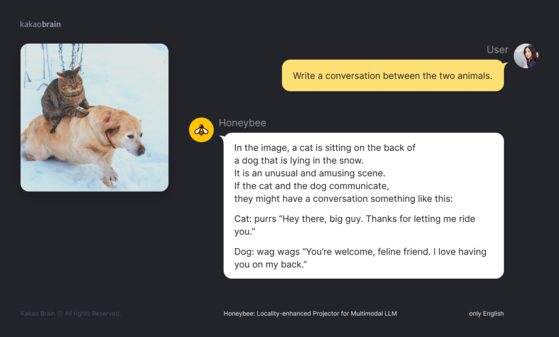TL;DR:
- Kakao introduced its new multimodal AI model, “Honeybee,” at a prestigious conference.
- The source code was presented by Kakao’s future CEO, Chung Shin-a, highlighting the company’s AI development plans.
- Distinguished C-suite executives from various industries attended the event, emphasizing government policies and AI collaborations.
- Kakao Brain released Honeybee’s code on GitHub, offering developers access to this innovative technology.
- Honeybee is a module designed to enhance existing large language models (LLMs), enabling them to understand both text and images.
- The model demonstrated exceptional performance in global multimodality evaluation tests.
- Kakao Brain envisions Honeybee as a versatile educational tool with potential applications yet to be fully explored.
- Kakao’s journey in the AI race is marked by delays in releasing KoGPT 2.0, amidst internal controversies.
- Korean companies like Naver and LG AI Research have already launched their own LLMs, paving the way for AI integration in various sectors.
Main AI News:
In a pivotal move, Kakao introduced its groundbreaking multimodal AI model, known as “Honeybee,” at a prestigious conference hosted by the Ministry of Science and ICT. While the tech giant’s KoGPT 2.0 remains veiled, this unveiling marks a significant step in the company’s journey toward AI advancement.
The momentous occasion saw Chung Shin-a, the forthcoming CEO of Kakao, unveil the source code, shedding light on the company’s ambitious plans for AI model development and services. This conference gathered prominent C-suite executives from diverse industries, including platforms, telecommunications, beauty, TV, and robotics, converging to discuss government policies and AI collaborations. Notable attendees included representatives from industry leaders such as Samsung, LG, Doosan Robotics, Naver, and Amorepacific.
On the same day, Kakao’s research subsidiary, Kakao Brain, disseminated Honeybee’s code base via GitHub, offering developers an opportunity to harness its potential.
Notably, Honeybee’s source code is not a standalone large language model (LLM) but rather a versatile module designed for integration with other LLMs. This integration empowers LLMs with the ability to comprehend both textual and visual prompts.
For example, when a user inputs an image of two basketball players on a court into a Honeybee-integrated LLM and poses a question like, “How many times did the player on the left win?” in English, the model adeptly interprets both the image and text to provide an accurate response.
Honeybee has earned accolades for its exceptional performance in functionality tests conducted using various global multimodality evaluation protocols, including MME, MMBench, and SEED-Bench.
Kakao Brain envisions Honeybee as a transformative educational tool, capable of engaging users through simultaneous input of images and text queries. While specific applications for Honeybee are yet to be officially defined, the possibilities are boundless.
Kakao Brain CEO Kim Il-do stated, “We are actively exploring the adaptation of Honeybee across a range of services and will invest significant efforts in research and development to refine this AI model further.“
Kakao, although a late entrant to the global AI race catalyzed by OpenAI’s ChatGPT, is making strides in this field. Despite initial promises to release KoGPT 2.0 last year, the launch has been repeatedly postponed due to allegations of internal discord and controversial dealings related to the acquisition of K-pop agency SM Entertainment.
In contrast, Korean companies like Naver and LG AI Research have already introduced their LLMs, HyperCLOVA X and Exaone, respectively, in the past year. These models are finding applications across various online platforms and financial institutions, showcasing the rapid evolution of AI in South Korea.
Conclusion:
Kakao’s introduction of the “Honeybee” multimodal AI model signifies a significant step forward in the company’s AI endeavors. This move underscores Kakao’s commitment to remaining competitive in the AI market, despite previous setbacks. With the potential applications of Honeybee across various sectors, including education, Kakao’s presence in the AI industry is poised for expansion and innovation.

